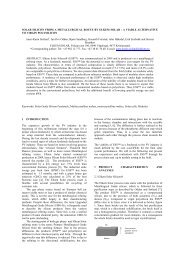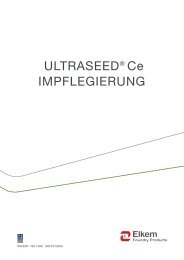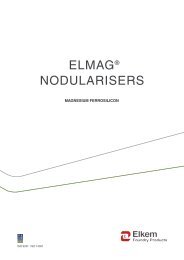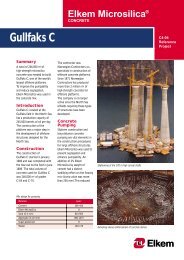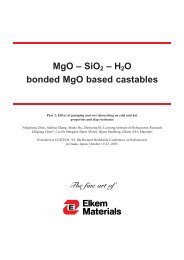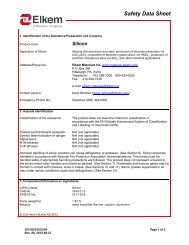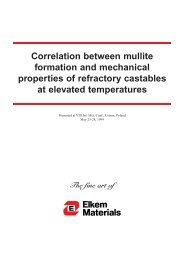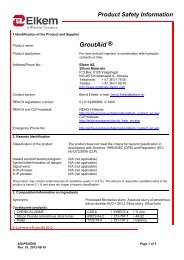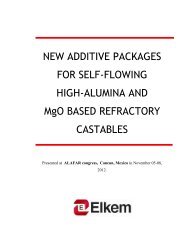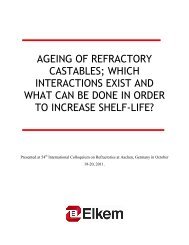Microsilica containing refractory castables - Elkem
Microsilica containing refractory castables - Elkem
Microsilica containing refractory castables - Elkem
Create successful ePaper yourself
Turn your PDF publications into a flip-book with our unique Google optimized e-Paper software.
characteristics of the resultant slurry are dependenton the charge and size of the cation that attaches. Inthe case of monovalent cations, the gelling actionhas been attributed to a mechanism where it’s thehydrated cations that link adjacent silica particles.Such a gel normally feels quite “soft” and easy toliquify by agitation, while that from polyvalentcations tend to have a more “brittle” and “harder”appearance. With polyvalent cations, it is easy toimagine that the excess positive charge of thecation links with another negative charge on anadjacent microsilica particle. In this way threedimensionalnetworks may form and this is whatwe normally regard as gelled microsilica.In <strong>castables</strong>, cations are generally available fromthe cement and aggregates, and it is likely that theinitial setting of most <strong>castables</strong> is closely related togelling of the microsilica <strong>containing</strong> slurry phase.In the case of ultralow and no-cement systems withmicrosilica, it is probable that most of the setting isdependent of this solidification although it is oftentriggered by small amounts of additives thatpromote the gelling. Such additives can e.g. besmall quantities of cement.The absorption of polyvalent cations on the silanolsites is most likely a dynamic process and requiresa certain concentration in the water phase beforeabsorption gets significant. The amounts of solublecations necessary for gelation are thereforeprobably higher than just to attach to the silanolsites, but it seems reasonable to expect that theorder of magnitude may be similar.The tendency to react with cations to produce amore or less rigid gel, creates problems if used indensely packed castable systems where cement ispresent. The calcium and aluminate cations fromthe cement dissolve and attack the otherwise fluidbond phase. To prevent this coagulation, thecalcium ions have to be prevented from absorbingon the microsilica. This may either be done byhaving a pH below 5, but as this may affect setting;addition of a proper amount of a polyelectrolyte ora surface active agent is a common stratagem. Thesurface active agent, normally termed deflocculant(in Portland cement based systems termedplasticiser or superplasticiser), is believed to absorbto the surfaces thus preventing the absorption ofcalcium but it also creates an equal, often negativecharge of the particles of the bond system. As theparticles then will repel each other, casting can takeplace at reduced water additions. Deflocculantscommonly used are polyphosphates, e.g. sodiumhexametaphosphate (Calgon) at approximately 0.2wt% addition level, and polyacrylates (Darvan811D, 0.05 wt %). The effect of Calgon onmicrosilica and reactive alumina is illustrated inFigure 4.Zeta-potential (mV)0.0-10.0-20.0-30.0-40.0-50.0-60.0-70.00 0.5 1 1.5 2 2.5Surfactant content (mg/m2)10% MS Slurry 5% Calgon10% CTC50 slurry 5% CalgonFigure 4: The effect of addition of Calgon. Zetapotential of 10% aqueous slurry of microsilica 971or CTC50 as a function of Calgon additionexpressed as mg/m 2 surface.The deflocculating mechanisms involved fallsnormally into two main groups or combinationthereof:1) Steric stabilisation, the deflocculant attaches tothe fines and the size of it preventsagglomeration of particles2) Electrostatic stabilisation, the deflocculantcreates an equal electrical charge on thesurface of the fines. Electrostatic repulsionprevents particles from agglomeration.3) Combination of 1) and 2):Additional to the above mechanisms, use ofdeflocculants makes it possible to maintain flow of<strong>refractory</strong> <strong>castables</strong> for some time, sufficient toplace the castable before setting (gelling)commences. Sometimes setting may get adverselyaffected though, giving unacceptably long or shortset times. This has been explained with severalmechanisms. For long set time withpolycarboxylate ethers, one explanation is that thesurface of the cement get “shielded” by the side



